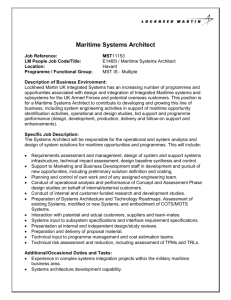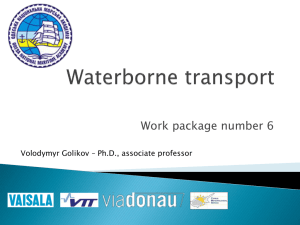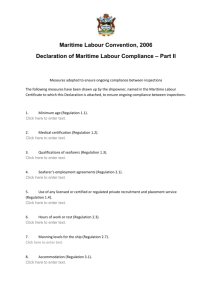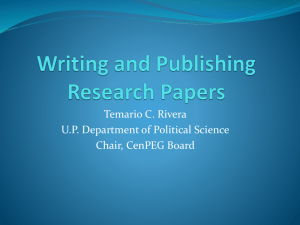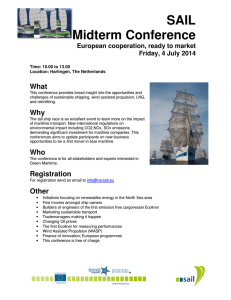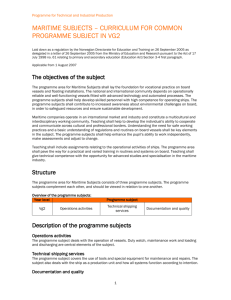eMar delivering Intelligent Maritime Single Window
advertisement
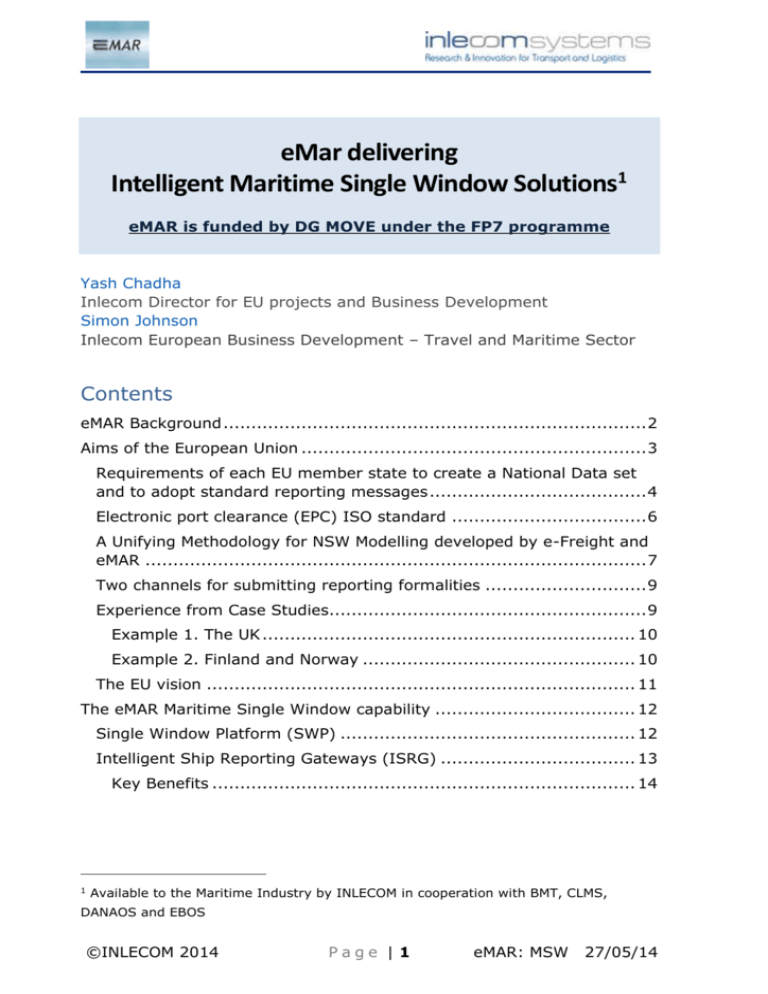
eMar delivering Intelligent Maritime Single Window Solutions1 eMAR is funded by DG MOVE under the FP7 programme Yash Chadha Inlecom Director for EU projects and Business Development Simon Johnson Inlecom European Business Development – Travel and Maritime Sector Contents eMAR Background ............................................................................ 2 Aims of the European Union .............................................................. 3 Requirements of each EU member state to create a National Data set and to adopt standard reporting messages ....................................... 4 Electronic port clearance (EPC) ISO standard ................................... 6 A Unifying Methodology for NSW Modelling developed by e-Freight and eMAR .......................................................................................... 7 Two channels for submitting reporting formalities ............................. 9 Experience from Case Studies......................................................... 9 Example 1. The UK ................................................................... 10 Example 2. Finland and Norway ................................................. 10 The EU vision ............................................................................. 11 The eMAR Maritime Single Window capability .................................... 12 Single Window Platform (SWP) ..................................................... 12 Intelligent Ship Reporting Gateways (ISRG) ................................... 13 Key Benefits ............................................................................ 14 1 Available to the Maritime Industry by INLECOM in cooperation with BMT, CLMS, DANAOS and EBOS ©INLECOM 2014 Page | 1 eMAR: MSW 27/05/14 eMAR Background The eMAR vision is to empower the European maritime sector in offering quality shipping services over an upgraded maritime transport information management infrastructure. eMAR will deliver: 1. An e-Maritime Strategic Framework (EMSF) specifying processes, standards and technologies that enable networking and computer supported co-operation between the principal maritime transport stakeholder groups. 2. A pilot implementation of the e-Maritime Strategic Framework, to establish upgraded solutions for acquiring essential data, handling it, exchanging it and sharing it in the most efficient way taking into consideration commercial confidentiality between stakeholders. An important eMAR focus is the Maritime Single Window providing a single point interaction between businesses and authorities. Although Single Window concepts and solutions were first developed for trade facilitation (Customs) in recent years significant progress has been made with transport centered Single Windows linked to sea traffic monitoring and port clearance (Maritime authorities). Ongoing developments in e-Freight and eMAR projects are aimed at rationalising and harmonising these two main development streams. Directive 2010/65/EU (commonly known as the ‘FAL Directive’) mandates EU Member States to accept the fulfillment of ship reporting formalities only in electronic format and their transmission via a single window as soon as possible but no later than 1st of June 2015. EU Member States preparing for the implementation of the directive are naturally considering interactions between the different modes of transport: maritime, aviation, rail, road, inland navigation and cargo / passenger perspectives. ©INLECOM 2014 Page | 2 eMAR: MSW 27/05/14 Fig1 indicates that National Single Windows need to address four fundamental aspects: Facilitation of business compliance to applicable regulations Exchange of information between national authorities Information exchange with external systems Value added Services for competiveness and growth. Figure 1: National Single Windows Aims of the European Union The European Union’s stated aim of introducing a Maritime Single Window is driven by a desire to simplify the administrative burden for ships entering and leaving EU ports. The current reporting requirements are extremely onerous and due to elements of overlapping legislation there is often a need to submit similar information to different authorities in different formats. Furthermore, individual ports have their own by-laws so reporting requirements vary considerably. Very little information is transmitted electronically with paper forms the preferred media. In short, the current system is labour intensive, inefficient and delivers little value to any of the stakeholders. The EU began to streamline and standardise ship-reporting formalities by introducing a number of directives. These included the Vessel Traffic Monitoring & Information Systems (VTMIS), which made every European ©INLECOM 2014 Page | 3 eMAR: MSW 27/05/14 country responsible for introducing their own SafeSeaNet national application – operational since 2009. This means that all member states became interconnected via the SafeSeaNet 2 Community system which provides a complete view of the movement of ships and dangerous or polluting cargo in European waters. Although initially difficult to roll out, SafeSeaNet has become very successful and is widely used for pollution control and pollution prevention. SafeSeaNet has also demonstrated what is possible in terms of Pan-EU cooperation in the maritime sector. In 2011 the EU introduced a policy to promote increased use of maritime transport by creating the European Maritime Transport Space Without Barriers. The concept is aimed to eliminate or simplify administrative procedures in intra-EU maritime transport, thus making it “more attractive, more efficient and more competitive“. As part of this, directive 2010/65/EU (Reporting formalities for ships) was introduced and this mandates the member states to adopt the electronic Maritime Single Window by 1 June 2015. It’s important to underline the Maritime Single Window because in the past there have been a number of single windows particularly associated with customs clearance. Requirements of each EU member state to create a National Data set and to adopt standard reporting messages The important element of directive 2010/65/EU is that each member state must introduce a Maritime Single Window so that ships arriving at EU ports can submit standard messages once, to a single point and that information will be disseminated as required to all authorities that need access to it. Furthermore, from 1 June 2015 the directive prohibits acceptance of reporting formalities in paper form so everything from that date will have to be submitted electronically. In terms of satisfying the EU’s goal of reducing the administrative burden for shipping companies, the deployment of the Maritime Single Window should, in the long term, be a major success with a number of additional benefits to ports and regulative bodies. The major issues lie in building and deploying a system that is flexible and fit for purpose. 2 SafeSeaNet a centralised European platform for maritime data exchange, linking together maritime authorities from across Europe – European Maritime Safety Agency EMSA ©INLECOM 2014 Page | 4 eMAR: MSW 27/05/14 In developing its national Maritime Single Window each EU country must specify a National Data Set reflecting all the regulatory requirements in that specific country. This National Data Set allows each country to include reporting requirements above and beyond what is specified as the minimum reporting requirements by the EU directives. The data model required by the EU as well as the standard messages to submit the information are being developed by the EU Expert Group on Maritime Administrative Simplification and Electronic Information Services (eMS) committee as well as the EU-funded Advanced National Network for Administrations (AnNa) project. All this development work is being carried out in parallel with similar EU single window projects for multimodal freight to promote potential interoperability. In developing its national Maritime Single Window each EU country must specify a National Data Set reflecting all the regulatory requirements in that specific country. This National Data Set allows each country to include reporting requirements above and beyond what is specified as the minimum reporting requirements by the EU directives. The data model required by the EU as well as the standard messages to submit the information are being developed by the EU Expert Group on Maritime Administrative Simplification and Electronic Information Services (eMS) committee as well as the EU-funded Advanced National Network for Administrations (AnNa) project. All this development work is being carried out in parallel with similar EU single window projects for multimodal freight to promote potential interoperability. ©INLECOM 2014 Page | 5 eMAR: MSW 27/05/14 The standard messages proposed by AnNa for Business to MSW are given in Table 1 No. Abbreviation Name 1 MAI Main / Identification vessel call 2 NOA Notice of Arrival / pre arrival information 3 COA Cancellation of Arrival / cancelling vessel call 4 ETA Notification of Expected Time of Arrival 5 ATA Notification of Actual Time of Arrival 6 NOD Notice of Departure / pre-departure information 7 ETD Notification of Expected Time of Departure 8 ATD Notification of Actual Time of Departure 9 EXP Notification of Expanded Inspection 10 SEC Notification of security information 11 WAS Declaration of ship generated waste and cargo residuals 12 PAX Notification of persons on board 13 EFF Declaration of crew's effects 14 MDH Maritime Declaration of Health 15 STO Declaration of Ship's Stores 16 ENS Entry Summary Declaration 17 SDT Summary Declaration of Temporary Storage 18 HZA Notification of Hazardous Materials on board at arrival 19 HZD Notification of Hazardous Materials on board at departure Table 1: Proposed standard Reporting Messages by maritime entities Electronic port clearance (EPC) ISO standard The IMO Facilitation Committee (FAL) decided in April 2013 to list ISO 28005 as a reference for XML based electronic port clearance systems (EPC) in the FAL Compendium. ISO 28005, "Security management systems for the supply chain – Electronic Port Clearance (EPC)"3. EPC currently consists of two parts: Part 1 is "Message structures – Implementation of a maritime single window system" and part 2 is "Core data elements". Core data elements cover all requirements for ship to shore and shore to ship reporting as defined in the following: 1. All FAL standard declarations (FAL 1 to 7) as defined in the FAL Convention [FAL]; 3 http://www.iso.org/iso/catalogue_detail.htm?csnumber=61323 ©INLECOM 2014 Page | 6 eMAR: MSW 27/05/14 2. ISPS reporting requirements as defined in [ISPS] and [MSC 1305]; 3. All general ship reporting requirements as defined in [A.851]4; 4. Recommended reporting on ship generated waste as defined in [MEPC 644] and which is mandatory in Europe as described in [EU/2000/59]; 5. Required reporting as defined in the bulk loading and unloading code [A.862]; 6. ETA reporting to pilot station as defined in [A.960]5. ISO/PAS 28005-1:2012 allows different configurations of the single window (SW), from a minimum solution to support basic clearance requirements to a more complex system to facilitate more extensive cooperation between ship and shore organisations. The standard has been developed through a number of EU-projects, and e-Freight has been responsible for the finalisation of the standard and the work towards IMO FAL approval. A Unifying Methodology for NSW Modelling developed by e-Freight and eMAR Both under e-Freight and eMAR, Inlecom in cooperation with BMT and CLMS has developed a model driven development environment addressing the key challenges of interoperability, confidentiality and change management. The main MSW modelling components are shown in the figure 2. Ship Formalities, Cargo Clearance and Coordinated Border Management Services Rules MSW Classes and Data Model National Legislation Other EU Internat regulations 2002/59 VTM Minimum set of Data Elements in 2010/65 National MSW Data Set MSW Messages [mapping to Data Communication Ship Formalities, Cargo Clearance and Coordinated Border Management Processes Model ] Fig 2: MSW modelling components IMO Assembly Resolution A.851 (20), General Principles for Ship Reporting Systems and Ship Reporting Requirements, Including Guidelines for Reporting Incidents Involving Dangerous Goods, Harmful Substances and/or Marine Pollutants. 5 IMO Resolution A.960(23) - Recommendations on Training and Certification and on Operational Procedures for Maritime Pilots other than Deep-Sea Pilots 4 ©INLECOM 2014 Page | 7 eMAR: MSW 27/05/14 The data elements that must be included in the MSW can be derived by the relevant legislation/directives. This data set specification should include name, description, format and reference standard. The minimum data set can be specified with reference to 2010/65. However all related directives should be addressed, including national legislation and port specific laws were applicable. Further, harmonisation with other modes has advantages, so additional data elements could be added. Further, known future requirements could be included. The data model CRS (Common Reporting Schema) as the name implies supports a unified solution for regulatory information management associated with trade and transport at both National, EU and international levels. CRS, initially developed in the e-Freight project it is being refined under eMAR to provide the data model and messages for MSWs with knowledge of current standards and harmonised with similar initiatives such as the ANNA project and data mapping activities carried out by EMSA. It allows the alignment of regulatory and standardisation developments whilst ensuring that users can report the right information at the right time. The CRS has been tested for submission of formalities under various scenarios, including submissions to Customs ICS systems, submissions to SSN via National Single Windows, and recently submissions by the DNV Navigator and other ship applications particularly with DANAOS. More recently eMAR is testing EPS messages with the MSW prototype produced by EMSA (IMP) in close cooperation with the Norwegian Coastal Administration. A major advantage of CRS is that it is structured to represent accurately both a cargo and ship / voyage perspectives. It has been constructed talking into account the main international standards, particularly WCO and ISO. It has been designed as part of the e-freight and eMaritime frameworks so that information can be extracted from normal operational data. ©INLECOM 2014 Page | 8 eMAR: MSW 27/05/14 Two channels for submitting reporting formalities There will be two main channels for submitting reporting formalities to Maritime Single Windows. 1. Through the Port Community Systems or other port systems that the industry is already using. These systems have a proven track record in transmitting information to various authorities electronically. This methodology reflects current electronic reporting routes used for example in in the UK, Holland, France and Spain. 2. Through reporting gateways and reporting applications that shipping companies and their agents may decide to use by extending their own systems or by adopting new/extended compliance applications. This approach is followed by for example Finland and Norway that operate central single window systems, which transmit information to ports. Both routes have their merits and it’s possible that both will be made available interconnected in order to provide maximum flexibility for all stakeholders. A key issue during the roll-out of the Maritime Single Window is supporting the stakeholders through the transition period and ensuring that there is contingency measures to deal with ‘not ready parties’. It would be unsatisfactory for ship owners to switch to all electronic reporting only to find that some ports are still asking for reporting using more traditional methods. Experience from Case Studies Over 30 countries from all regions of the world have introduced a Single Window facility (mainly for Customs) and have achieved considerable advantages: 1. Reduction of time and resources required by businesses in preparing, presenting and processing reporting requirements with an associated decrease in trade transaction costs. 2. Improved trader compliance through more complete, accurate and timely data submission with an associated increase in government revenues, and more efficient and effective border management and control. ©INLECOM 2014 Page | 9 eMAR: MSW 27/05/14 Preparations for the MSW in Europe are underway with pilots planned particularly under the AnNa project but also by eMAR and new eCompliance project 6 – all EU supported activities cooperating for maximum benefit to the shipping industry. Example 1. The UK Taking the UK as an example of a country without a legacy single window system, all the interested government agencies, HM Revenue and Customs (HMRC), the Home Office, the Maritime and Coastguard Agency (MCA), the Port Health Authority and the Department of Transport established a steering group early in the process to look at technical and policy issues and provide direction on developments. Inlecom has been working with the steering group together with BMT as part of the eMAR project to address each agency’s differing requirements within the context of a UK system that’s not only fit but purpose but also future-proof. This has engendered a pragmatic approach recognising that the needs of the user must be paramount. Consequently the steering group has stipulated that rolling-out the Maritime Single Window at a least possible cost for the industry must be a high priority. While 90 of the UK’s large and intermediate ports are already electronically linked to the MCA there are approximately 250 medium and small ports that have no direct connection. Rather than demanding that these 250 ports invest in an expensive direct connection, information can be input manually through a Maritime Single Window web interface. Example 2. Finland and Norway Countries such as Finland that already has a single window and Norway that has an extended SSN application in place covering many functionalities of MSW have a different set of issues to contend with. In the main, suitable infrastructure is already in place so the major task will be updating the National Data Set to reflect the reporting formalities data model and standard messages. While stakeholders using the system are used to the process of submitting the reporting information to a single point of contact, they will be faced with different reporting messages. If support is readily available for users, this need not be an issue. 6 www.e-compliance-project.eu ©INLECOM 2014 P a g e | 10 eMAR: MSW 27/05/14 The EU vision The EU vision is to move to a situation depicted by Figure 3 with interconnected Maritime Single Windows and shipping networks. Towards that goal Inlecom has developed connectivity infrastructure in iCargo and eMAR projects which is utilized by the Inlecom eMAR platform and the DANAOS eMAR platform The Maritime Single Window is effectively a connectivity mechanism between Businesses and Authorities Figure 3: a vision for interconnected MSWs and shipping networks ©INLECOM 2014 P a g e | 11 eMAR: MSW 27/05/14 The eMAR Maritime Single Window capability Inlecom has established a unique set of tools facilitating fast and dependable development of SW solutions both for authorities and shipping companies. The use of the eMAR framework and ontologies from related domains offers new possibilities for intelligent solution particularly in superior self-configuration and interoperability features. Figure 4: A unique set of SW development tools for shipping companies and Authorities Single Window Platform (SWP) The proposed solution for National Single Windows as the name implies is an application supported by a range of tools that facilitate specifically the continues harmonization of the MSW with changes in legislation but also changes in the systems by individual authorities and European platforms such as SafeSeaNet. The unique value proposition of SWP is that it allows member states to design and manage the MSW complying with 2010/65/EC directive but ©INLECOM 2014 P a g e | 12 eMAR: MSW 27/05/14 allowing autonomy for the different authority systems and the way information is shared. The main modules are 1. Information Exchange between Reporting Parties and NSW via the intelligent Ship Reporting Gateways (ISRG – refer below): receives an maritime formalities message (MRF) or a custom formalities message (CRF) and stores it to NSW database or distributes to specified databases. sends an acknowledgement message to Reporting Parties via the ISRG depending if required by national legislation based on the configuration made by the national Administrator. 2. Information Exchange between NSW and SafeSeaNet 3. Information Exchange between NSW and Authorities’ systems (Systems Configuration) Administrator can configure the Access Components for the authorities’ systems. Routing engine 4. Users Management Administrator can configure the Access Rights for the Users configuration specifies who will have access to the NSW and what permissions each user will have (e.g. View, Consult, Approve) Migration / Synchronizer with existing authorization systems. 5. Authorities Dashboard Web interface for displaying information regarding Formalities, Notifications, etc to different roles in different authorities. Personalization assistants. Intelligent Ship Reporting Gateways (ISRG) An innovative software application, enabling shipping Industry representatives to fulfil their reporting obligations to European Maritime & Custom Authorities, in accordance to the European Commission Directives: 2009/17/EC: 24h pre-arrival notice, Hazmat, notices to maritime reporting systems and vessel traffic services. 2009/16/EC: 72h pre-arrival notice, actual arrival / departure notifications ©INLECOM 2014 P a g e | 13 eMAR: MSW 27/05/14 2010/65/EC: ship reporting formalities such as waste, security, FAL forms, maritime declaration of health, entry summary declaration, passenger list, crew effects, cargo manifests, etc. The application is designed for: 1. Easy configuration of the: a. Communication with the Maritime and Custom Authority systems in a variety of electronic formats and in accordance with the rules applicable per country and/ or port visited by the reporting ships. b. Users profiles/access rights. 2. Full compliance with European Union legal requirements on ship and cargo reporting. Additional reporting requirements are included based on a case-by-case request of a customer 3. Easy maintenance of reference data repeated frequently in notifications (e.g. ship particulars, port location codes) 4. Easy customisation of the application in order to be utilised, based on specific requirements: a. Ashore, by Ship Managers/Operators/Ship Agents/Cargo Consignors and forwarders b. On board ships, by Ship’s authorised staff (e.g. ship masters) 5. Interfacing to existing ship applications for automated extraction of required data 6. Automated updating of data models to adhere to new regulations Key Benefits A highly flexible and user-friendly tool for linking voyage/ ship cargo planning information with port formalities reporting for use on-board and ashore. Streamlining of the reporting work-flows facilitating the exchange of ship and cargo information among all the actors involved in reporting, respecting their access rights on a “need-to-know” basis. Reduction of the reporting burden (from hours to minutes) allowing ship industry staff to focus on efficiency and safety of operations. Reduction of the overall cost of reporting by eliminating non-adding value intermediaries. Reduction of IT complexity. Easy integration / sharing of information with other company “in-house” systems providing reference data for fulfilling reporting requirements and/ or vessel tracking. Compliance with international standards (e.g. ISO 28005, WCO, EDIFACT) and EU specific formats and requirements. Contact Inlecom to arrange a meeting to discuss. ©INLECOM 2014 P a g e | 14 eMAR: MSW 27/05/14 Simon Johnson Simon@inlecom.com M +44 (0) 7801 033177 Yash Chadha Yash@inlecom.com M + 44 (0) 7734 654321 http://www.inlecom.com ©INLECOM 2014 P a g e | 15 eMAR: MSW 27/05/14


